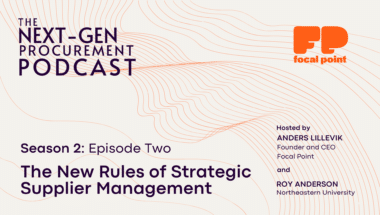In today’s business climate, procurement knows it’s not just about cutting costs anymore; it’s about playing a major role in driving the company forward. During their most recent Community Q&A webinar, Amanda Prochaska of Wonder Services and Focal Point’s Anders Lilleivk got into the nitty-gritty of what makes a solid business case for procurement, the role of interpersonal relationships in procurement’s success, and the big-picture value procurement adds. Explore key takeaways from their insights below.
Establishing the Baseline
It’s impressive how quickly procurement has moved from being all about the dollars saved to being a key contributor in major areas like risk management, diversity and inclusion, ESG, and contract management. But communicating this increase in scope of value provided can be a challenge. Procurement organizations looking to communicate their contributions effectively and facilitate organizational buy-in should first take inventory of all of their team’s efforts (you can learn more about how to establish a Procurement Scorecard here.)
Success Lies in a Strong Business Case
When you’re putting together a business case for procurement, you’ve got to look at the whole picture. An effective digital procurement solution empowers your team, but should also help to serve the needs of project stakeholders, vendors and leadership. When presenting your business case to each of these audiences, then, it is crucial to explore how the right solution (or funding) will ultimately benefit their needs.
For instance – explore how procurement might aid a category in meeting carbon reduction goals, or how enforcing on-contract spend might reduce overall project costs. You can learn more about how procurement can help meet non-financial goals here.
Overcoming Objection
It’s common to hit some skepticism, especially when tech vendors are promising the moon. The key is to keep it real when you communicate.
“We have so many competing priorities and organizations and typically the customer facing and revenue generating departments, organizations tend to get the first, second and third dollar, and maybe procurement gets the fifth or sixth at some point in time,” Anders shared, “but it’s really about advocating.”
By communicating clearly about the financial and strategic benefit specific to each end user’s needs, procurement can ensure that investment in their success isn’t a competing priority, but a priority in the effort to meet an organization’s existing goals.
Putting a Number on Procurement’s Value
Measuring what procurement brings to the table, especially the not-so-obvious stuff, is more of an art. It’s all about setting clear goals, both for the short haul and the long run, and making sure every deal with suppliers is in line with these goals. Historically, disparate project record and manual data entry has made this difficult.
But with the right digital procurement tool, all requests and efforts should be visible for CPOs – making quantifying progress towards projects by category (and communicating these wins) easy. This way, procurement is clearly contributing to the big picture, like sustainability, diversity, and of course spend reduction. Read more about how the right tool can bring clarity to your organization’s processes here.
Sweetening the C-Suite
To get the thumbs up from leadership, it’s about telling a compelling story. Show them a vision of the future that they can get behind, highlighting the concrete journey to potential wins. Being upfront about the hurdles (and your plan to overcome them, with their buy-in) makes your case more trustworthy.
Also, tapping into your network and lining up your case with what the decision-makers see as top priorities can really make an impact.
Lillevik encourages procurement to keep relationship-building at the forefront: “I think some procurement folks tend to underestimate the value of having procurement as a “brand” to be able to communicate with your stakeholders, giving them regular updates and actually being on a first name basis with decision makers and their lieutenants as well.”
Wrapping Up
There’s no denying the strategic muscle procurement brings to the digital transformation table. As companies wade through the digital era’s challenges, procurement is leading the charge, not just trimming expenses but shaping the path to success. By putting together convincing, well-rounded business cases and clearly communicating procurement’s broader contributions, pros in this arena can rally the support and resources needed for real change.



